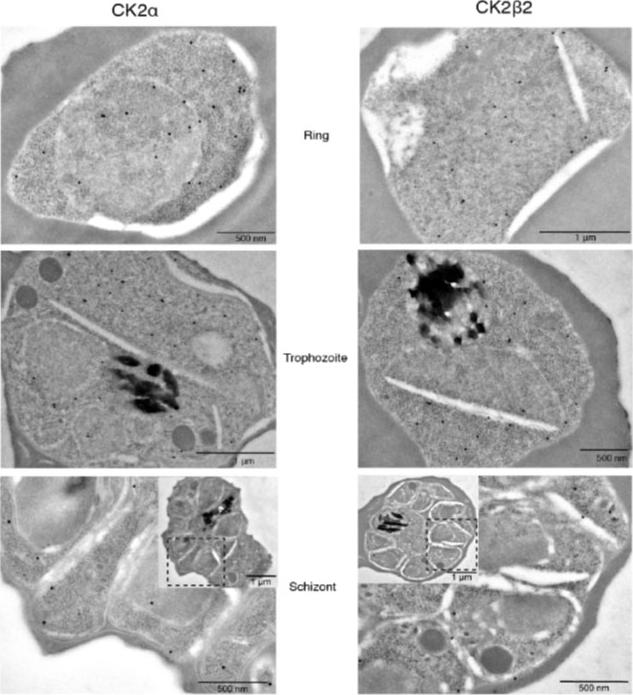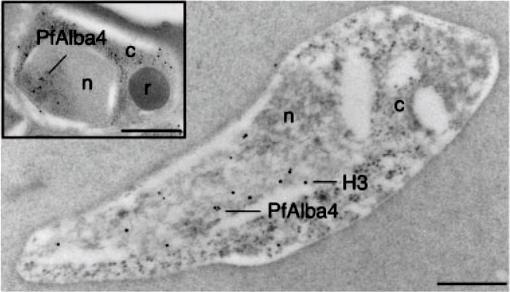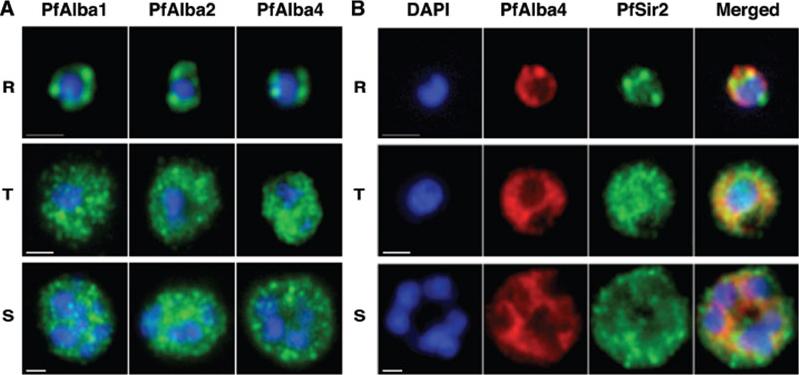PVX_083270 DNA/RNA-binding protein Alba 4, putative (ALBA4)
Disruptability [+]
| Species | Disruptability | Reference | Submitter | |
|---|---|---|---|---|
| P. berghei ANKA |
Possible |
PlasmoGEM (Barseq) | PlasmoGEM | |
| P. falciparum 3D7 |
Refractory |
USF piggyBac screen (Insert. mut.) | USF PiggyBac Screen | |
| P. yoelii yoelii 17X |
Possible |
RMgm-1129 | Imported from RMgmDB | |
| P. yoelii yoelii 17X |
Possible |
RMgm-4313 | Imported from RMgmDB | |
| P. yoelii yoelii 17X |
Possible |
RMgm-4632 | Imported from RMgmDB | |
Mutant phenotypes [+]
| Species | Stage | Phenotype | Reference | Submitter |
|---|---|---|---|---|
| P. berghei ANKA | Asexual |
Attenuated |
PlasmoGEM (Barseq) | PlasmoGEM |
| P. yoelii yoelii 17X | Asexual |
No difference |
RMgm-4313 | Imported from RMgmDB |
| P. yoelii yoelii 17X | Asexual |
No difference |
RMgm-4632 | Imported from RMgmDB |
| P. yoelii yoelii 17X | Gametocyte |
Difference from wild-type |
RMgm-4313
No differences in total gametocytemia, sex ratio, or mature-immature gametocyte ratio; two-fold increase in the number of activated male gametes. |
Imported from RMgmDB |
| P. yoelii yoelii 17X | Gametocyte |
Difference from wild-type |
RMgm-4632
Two- to three-fold increase in the number of activated male gametes. |
Imported from RMgmDB |
| P. yoelii yoelii 17X | Oocyst |
Difference from wild-type |
RMgm-1129
Pyalba4(-) parasites exhibit a significant decrease in the number of oocysts by Day 7 post-mosquito feed and a significant decrease in oocyst- and salivary gland sporozoites on Days 10 and 14, respectively. |
Imported from RMgmDB |
| P. yoelii yoelii 17X | Oocyst |
Difference from wild-type |
RMgm-4313
No significant differences in the prevalence of mosquito infection, oocyst numbers, nor in the total number of sporozoites per infected mosquito (the sum of midgut and salivary gland sporozoites)A significant effect was observed upon the semi-synchronous egress of sporozoites from oocysts in the midgut and their arrival in the salivary gland; pyalba4- parasites continue to egress from the oocysts over time and are capable of invading the salivary gland and are highly infectious to mice. |
Imported from RMgmDB |
| P. yoelii yoelii 17X | Sporozoite |
Difference from wild-type |
RMgm-1129
Pyalba4(-) parasites exhibit a significant decrease in the number of oocysts by Day 7 post-mosquito feed and a significant decrease in oocyst- and salivary gland sporozoites on Days 10 and 14, respectively |
Imported from RMgmDB |
| P. yoelii yoelii 17X | Sporozoite |
Difference from wild-type |
RMgm-4313
A significant effect was observed upon the semi-synchronous egress of sporozoites from oocysts in the midgut and their arrival in the salivary gland; pyalba4- parasites continue to egress from the oocysts over time and are capable of invading the salivary gland and are highly infectious to mice. |
Imported from RMgmDB |
| P. yoelii yoelii 17X | Liver |
No difference |
RMgm-4313 | Imported from RMgmDB |
Imaging data (from Malaria Metabolic Pathways)

Localization of PfCK2 subunits over the life cycle of the bloodstage parasite (A-C) Hemagglutinin (HA)-tagged PfCK2 subunits (green) localized to both nuclear and cytoplasmic compartments in rings, trophozoites and schizonts. The limits of the parasitophorous vacuole membrane (PVM) are marked by Exp-2 (red). (D) HA-tagged PfCK2 subunits were detected in both the cytoplasmic and nuclear fraction. A signal for all three subunits was detectable in both the cytoplasmic and nuclear compartments of the parasite.Dastidar EG, Dayer G, Holland ZM, Dorin-Semblat D, Claes A, Chene A, Sharma A, Hamelin R, Moniatte M, Lopez-Rubio JJ, Scherf A, Doerig C. Involvement of Plasmodium falciparum protein kinase CK2 in the chromatin assembly pathway. BMC Biol. 2012 Jan 31;10(1):5.
See original on MMP
Immuno-electron microscopy of the hemagglutinin (HA)-tagged PfCK2α and PfCK2β2 subunits. Immuno-electron microscopy was performed with an anti-HA antibody on ring-, trophozoite- and schizont-stage parasites from the HA-tagged lines. HAPfCK2α and HA-PfCK2β2 localized to both cytoplasmic and nuclear compartments in accordance with our IFA and Western-blot data.Dastidar EG, Dayer G, Holland ZM, Dorin-Semblat D, Claes A, Chene A, Sharma A, Hamelin R, Moniatte M, Lopez-Rubio JJ, Scherf A, Doerig C. Involvement of Plasmodium falciparum protein kinase CK2 in the chromatin assembly pathway. BMC Biol. 2012 Jan 31;10(1):5.
See original on MMP
Immuno-EM was performed on ring stage parasites using anti-PfAlba4 antibodies (Ab 237–2) bound to 10nm gold particles and anti-H3 antibodies bound to 15nM gold particles. The inset shows a single developing merozoite within schizont-stage parasites labeled with anti-PfAlba4 antibodies (Ab 237–2) bound to 10nm gold particles; n=nucleus, c=cytoplasm, r=rhoptry; Scale bars represent 500 nm. In the ring stage, we detected PfAlba4 uniquely in the nucleus. Since the nuclear membrane is difficult to visualize in immuno-EM in the ring stage, co-labeling with antibodies directed against histone H3 was used to determine the area of the nucleus in this parasite form. The images localize PfAlba4 at the nuclear periphery. This pattern was confirmed in developing merozoites (inset) where distinct clusters of PfAlba4 could be detected at the periphery of the nuclei.Chêne A, Vembar SS, Rivière L, Lopez-Rubio JJ, Claes A, Siegel TN, Sakamoto H, Scheidig-Benatar C, Hernandez-Rivas R, Scherf A. PfAlbas constitute a new eukaryotic DNA/RNA-binding protein family in malaria parasites. Nucleic Acids Res. 2011 Dec 13. [Epub ahead of print]
See original on MMP
PfAlbas localize to perinuclear foci in ring stages and expand to the cytoplasm in mature forms. (A) Immunofluorescence analysis of PfAlba1, PfAlba2 and Pfalba4 distribution throughout the parasite life cycle (Rings, Trophozoites, Schizonts). The anti-PfAlba antibodies (Ab 74–2 for PfAlba1; Ab 233 for PfAlba2; Ab 237–2 for PfAlba4) were used at 5.5, 4.5 and 8 mg/ml, respectively. Anti-rabbit Alexa-488 secondary antibodies (Molecular Probes) were used at a dilution of 1:500. Scale bars represent 1 mm. (B) Immunofluorescence analysis of 3D7 Rings, Trophozoites and Schizonts stained with anti-PfAlba4 (red) and anti-PfSir2 (green) antibodies. Scale bar represents 1 mm.Chêne A, Vembar SS, Rivière L, Lopez-Rubio JJ, Claes A, Siegel TN, Sakamoto H, Scheidig-Benatar C, Hernandez-Rivas R, Scherf A. PfAlbas constitute a new eukaryotic DNA/RNA-binding protein family in malaria parasites. Nucleic Acids Res. 2012 40(7):3066-77
See original on MMPMore information
| PlasmoDB | PVX_083270 |
| GeneDB | PVX_083270 |
| Malaria Metabolic Pathways | Localisation images Pathways mapped to |
| Previous ID(s) | Pv083270 |
| Orthologs | PBANKA_1360300 , PCHAS_1364900 , PF3D7_1347500 , PKNH_1253400 , PVP01_1207300 , PY17X_1366000 |
| Google Scholar | Search for all mentions of this gene |